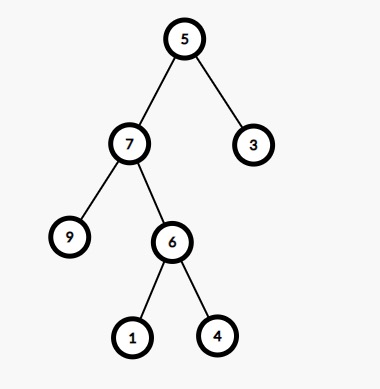Table of Contents
Problem Statement
The problem asks to find “Inorder Successor of a node in Binary Tree”. An inorder successor of a node is a node in the binary tree that comes after the given node in the inorder traversal of the given binary tree.
Example
Inorder successor of 6 is 4
Explanation
The inorder traversal of the tree is 9 7 1 6 4 5 3. Thus the inorder successor of 1 is 6.
Approach
Generally, we are told to find the next node in inorder traversal of a binary search tree. But that is different from that of a binary tree. So one thing which we should note is that the inorder traversal of a general binary tree is not in ascending order. Now let’s move ahead. So if we have a node then there are 3 cases which we should look upon.
The 3 cases which we should note are related to its right child or if the current node itself is a rightmost child. So if the node has a right child. Then inorder successor is simply the leftmost child in its right subtree. But if it does not have the right child. Then find the lowest ancestor of the given node such that the given node lies in the left subtree of the ancestor. For doing this, recursively find the node, and when we move back from recursion store the parent from where we have chosen the left direction.
Now the last case is if the node is the rightmost child. If that happens there does not exist any inorder successor for the node.
Code
C++ code to find Inorder Successor of a node in Binary Tree
#include<bits/stdc++.h>
using namespace std;
struct node {
int data;
node *left, *right;
};
node* create(int data){
node* tmp = new node();
tmp->data = data;
tmp->left = tmp->right = NULL;
return tmp;
}
node* findLeftMostNode(node* root){
while(root && root->left) root = root->left;
return root;
}
node* findRightMostNode(node* root){
while(root && root->right) root = root->right;
return root;
}
node* findAncestorSuccessor(node* root, node* given)
{
if(root){
if(root == given)
return root;
node* tmp = findAncestorSuccessor(root->left, given);
if(tmp){
if(root->left == tmp){
cout<<"Inorder Successor of "<<given->data<<" is "<<root->data;
return NULL;
}
return root;
}
tmp = findAncestorSuccessor(root->right, given);
if(tmp){
if(root->left == tmp){
cout<<"Inorder Successor of "<<given->data<<" is "<<root->data;
return NULL;
}
return root;
}
}
return NULL;
}
void findInorderSuccesor(node* root, node* given)
{
// if right child exists
if(given->right)
{
node* leftmost = findLeftMostNode(given);
cout<<"Inorder Succesor of "<<given->data<<" is "<<leftmost->data;
return;
}
// if right child does not exists
if(given->right == NULL)
{
node* rightmost = findRightMostNode(root);
if(rightmost == given)
cout<<"Inorder Successor does not exists";
else
findAncestorSuccessor(root, given);
}
}
int main()
{
node* root = create(5);
root->left = create(7);
root->right = create(3);
root->left->left = create(9);
root->left->right = create(6);
root->left->right->left = create(1);
root->left->right->right = create(4);
findInorderSuccesor(root, root->left->right->left);
}
Inorder Successor of 1 is 6
Java code to find Inorder Successor of a node in Binary Tree
import java.util.*;
class node{
int data;
node left, right;
}
class Main{
static node create(int data){
node tmp = new node();
tmp.data = data;
tmp.left = tmp.right = null;
return tmp;
}
static node findLeftMostNode(node root){
while(root != null && root.left != null) root = root.left;
return root;
}
static node findRightMostNode(node root){
while(root != null && root.right != null) root = root.right;
return root;
}
static node findAncestorSuccessor(node root, node given)
{
if(root != null){
if(root == given)
return root;
node tmp = findAncestorSuccessor(root.left, given);
if(tmp != null){
if(root.left == tmp){
System.out.print("Inorder Successor of "+given.data+" is "+root.data);
return null;
}
return root;
}
tmp = findAncestorSuccessor(root.right, given);
if(tmp != null){
if(root.left == tmp){
System.out.print("Inorder Successor of "+given.data+" is "+root.data);
return null;
}
return root;
}
}
return null;
}
static void findInorderSuccesor(node root, node given)
{
// if right child exists
if(given.right != null)
{
node leftmost = findLeftMostNode(given);
System.out.print("Inorder Successor of "+given.data+" is "+leftmost.data);
return;
}
// if right child does not exists
else
{
node rightmost = findRightMostNode(root);
if(rightmost == given)
System.out.print("Inorder Successor does not exists");
else
findAncestorSuccessor(root, given);
}
}
public static void main(String[] args)
{
node root = create(5);
root.left = create(7);
root.right = create(3);
root.left.left = create(9);
root.left.right = create(6);
root.left.right.left = create(1);
root.left.right.right = create(4);
findInorderSuccesor(root, root.left.right.left);
}
}Inorder Successor of 1 is 6
Complexity Analysis
Time Complexity
O(N), because in worst cases we may have to traverse over all of the nodes.
Space Complexity
O(H), since we have used recursion. Thus if we consider the space taken by compiler stack. The space complexity is dependent on the height of the tree.
